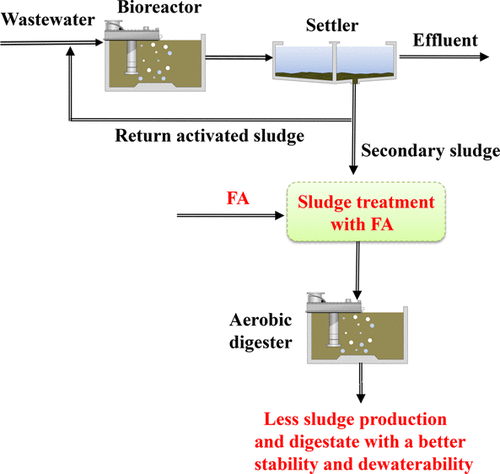当前位置:
X-MOL 学术
›
ACS Sustain. Chem. Eng.
›
论文详情
Our official English website, www.x-mol.net, welcomes your feedback! (Note: you will need to create a separate account there.)
Free Ammonia Pretreatment Improves Degradation of Secondary Sludge During Aerobic Digestion
ACS Sustainable Chemistry & Engineering ( IF 8.4 ) Pub Date : 2017-11-15 00:00:00 , DOI: 10.1021/acssuschemeng.7b03403 Qilin Wang 1, 2 , Wei Wei 3 , Sitong Liu 4 , Mingquan Yan 4 , Kang Song 5 , Jingjing Mai 1 , Jing Sun 6 , Bing-Jie Ni 6 , Yanyan Gong 7
ACS Sustainable Chemistry & Engineering ( IF 8.4 ) Pub Date : 2017-11-15 00:00:00 , DOI: 10.1021/acssuschemeng.7b03403 Qilin Wang 1, 2 , Wei Wei 3 , Sitong Liu 4 , Mingquan Yan 4 , Kang Song 5 , Jingjing Mai 1 , Jing Sun 6 , Bing-Jie Ni 6 , Yanyan Gong 7
Affiliation

|
Aerobic digestion is commonly used to achieve secondary sludge reduction in the small-size wastewater treatment plants. Nevertheless, secondary sludge degradation is usually restricted by the slow hydrolysis rate and low degradable percentage of secondary sludge. Here, we present an innovative approach using pretreatment of free ammonia (FA, i.e. NH3), a renewable chemical from wastewater, to improve the degradation of secondary sludge during aerobic digestion. The secondary sludge was degraded by 36 ± 4% (volatile solids (VS) basis) within 15 days of aerobic digestion while being pretreated at 300 mg NH3–N/L (pH 9.0; total ammonia nitrogen = 800 mg N/L) for 24 h, whereas only 23 ± 3% (VS basis) of the secondary sludge without FA pretreatment was degraded over the same period. Similarly, the production of inorganic nitrogen also increased from 27 ± 2 to 38 ± 2 mg N/g VS after implementing FA pretreatment, corroborating the idea that degradation of secondary sludge was effectively improved by FA pretreatment. Further analysis by model revealed that the improved hydrolysis rate and increased degradable percentage of secondary sludge were responsible for the enhanced sludge degradation in aerobic digestion. It was also found that FA pretreatment would produce an aerobic digestate with a better stability and dewaterability, as indicated by the lower degradable percentage of digestate and the decrease of capillary suction time from 38 ± 1 to 34 ± 1 s, respectively. Economic analysis indicates that the FA pretreatment approach would be economically favorable when the sludge transport and disposal cost is higher than $40/wet tone.
中文翻译:

游离氨预处理可改善有氧消化过程中次级污泥的降解
在小型废水处理厂中,好氧消化通常用于实现二次污泥的减少。然而,次生污泥的降解通常受到次生污泥水解速度慢和可降解百分比低的限制。在这里,我们提出了一种创新方法,该方法使用预处理废水中的可再生化学物质游离氨(FA,即NH 3)来改善需氧消化过程中二次污泥的降解。二级污泥在需氧消化后的15天内降解了36±4%(以挥发性固体(VS)为基准),同时以300 mg NH 3进行了预处理-N / L(pH 9.0;总氨氮= 800 mg N / L)持续24小时,而同期未经FA预处理的二次污泥仅降解23±3%(以VS为基准)。同样,实施FA预处理后,无机氮的生产量也从27±2增加到38±2 mg N / g VS,从而证实了通过FA预处理可有效改善次生污泥降解的想法。通过模型进一步分析表明,提高的水解速度和增加的次级污泥可降解百分比是有氧消化中污泥降解增强的原因。还发现FA预处理将产生具有更好稳定性和脱水性的好氧消化物,这表明消化物的降解率较低,毛细管抽吸时间从38±1 s减少至34±1 s,分别。经济分析表明,当污泥的运输和处置成本高于$ 40 /湿基时,FA预处理方法在经济上将是有利的。
更新日期:2017-11-16
中文翻译:

游离氨预处理可改善有氧消化过程中次级污泥的降解
在小型废水处理厂中,好氧消化通常用于实现二次污泥的减少。然而,次生污泥的降解通常受到次生污泥水解速度慢和可降解百分比低的限制。在这里,我们提出了一种创新方法,该方法使用预处理废水中的可再生化学物质游离氨(FA,即NH 3)来改善需氧消化过程中二次污泥的降解。二级污泥在需氧消化后的15天内降解了36±4%(以挥发性固体(VS)为基准),同时以300 mg NH 3进行了预处理-N / L(pH 9.0;总氨氮= 800 mg N / L)持续24小时,而同期未经FA预处理的二次污泥仅降解23±3%(以VS为基准)。同样,实施FA预处理后,无机氮的生产量也从27±2增加到38±2 mg N / g VS,从而证实了通过FA预处理可有效改善次生污泥降解的想法。通过模型进一步分析表明,提高的水解速度和增加的次级污泥可降解百分比是有氧消化中污泥降解增强的原因。还发现FA预处理将产生具有更好稳定性和脱水性的好氧消化物,这表明消化物的降解率较低,毛细管抽吸时间从38±1 s减少至34±1 s,分别。经济分析表明,当污泥的运输和处置成本高于$ 40 /湿基时,FA预处理方法在经济上将是有利的。


























 京公网安备 11010802027423号
京公网安备 11010802027423号